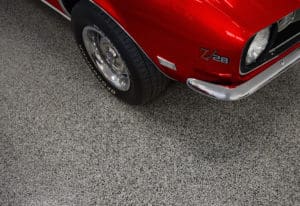Epoxy, Polyurethane and Polyurea Polyaspartic Coatings
Are you thinking about coating your garage, driveway or patio? Or maybe you want to coat an interior space like your basement, kitchen or home office. Or a large retail or commercial space? If you’ve done some research, you’ve likely heard of epoxy, polyurethane or polyurea polyaspartic coatings. It can be confusing to know the difference between these coating types. So we’ll it break down and show you when it comes to coatings “One size does not fit all”.
Why Should I Know the Difference?
Why is it important to know the difference between coating types? Because it’s an overcrowded floor coatings market out there. Inexperienced contractors and hardware store DIY kits abound. In recent years, popular fast-cure polyurea polyaspartic coatings have been mass-marketed as “1-day polyurea” systems (…to which we say: We can install a 1-day polyurea system too, but we’d rather do it right!).
The reality is that epoxy, polyurethane and polyurea polyaspartic coatings possess important advantages and disadvantages. Choose the wrong product for your project and you’ll be re-coating within a year! By knowing the pros and cons of the different coatings types, you won’t be enticed by unscrupulous contractors or “inexpensive” DIY kits.
The Right Coating Depends on Multiple Factors
The type of coating used should only be determined together by the customer and a professional installer following a thorough evaluation of the space to be coated. Whether an epoxy, polyurethane or polyurea polyaspartic is selected for use depends upon multiple factors specific to the space and substrate being coated. These factors include concrete moisture levels, exposure to ultraviolet light (driveways, patios), exposure to chemical stains (e.g., garages, kitchens), aesthetics, odor sensitivity, return-to-service duration…and of course…cost.
Understanding the advantages and disadvantages of an epoxy, polyurethane, polyurea polyaspartic, and how to properly use these products in combination, will provide you with the most durable coating system for your specific space. “Contractors” selling one-day installations and DIY kits sold at your nearest hardware store do not take these matters into consideration….the result is poor quality floor coating that will need to be recoated in the short term.
Difference Between Coating Types
The 3 main types of floor coating products include epoxy, polyurethane and polyurea polyaspartic. (In the table below, we simply refer to the latter as “polyaspartic”). Each coating type has different properties. In the table below, we outline these differences in cost, gloss, chemical and UV resistance, odor and whole lot more.
| PARAMETER | EPOXY | POLYURETHANE | POLYASPARTIC |
|---|---|---|---|
| Cost | Inexpensive relative to Polyaspartic | Inexpensive relative to Polyaspartic | Expensive |
| Gloss/Sheen | High gloss. | Variable sheens available (from matte to high gloss). | High gloss. |
| Chemical Resistance | Moderate to high chemical resistance. | High chemical resistance. | Extreme chemical resistance. |
| UV Resistance | Low UV resistance; ambers/chalks over time if exposed to sunlight. | High UV resistance. | Extreme UV resistance |
| Usability | Medium pot life. Moderate to difficult to apply. For experienced applicators only. | Slow to moderate cure rate, so relatively easy to apply over an epoxy-primed surface. | Short pot life, so difficult to apply. For experienced applicators only. |
| Odor | Low or medium odor (scent additive typically required for interior use). | Product dependent…from low odor to highly odorous. | Low to high odor (scent additive required for interior use). |
| Volatile Organic Compounds (VOCs) | Low VOC Hydro Epoxy to no VOC 100% Solids Epoxy. | Product dependent; from low to medium VOCs. | Ultra-low to no VOCs. |
| Moisture Resistance | Hydro Epoxy is highly resistant to moisture and is used as a moisture-mitigating primer coat. | Moisture resistant when cured but not designed for direct to concrete. | Moisture resistant when cured but not designed for direct to concrete. |
| Solids Content | 100% solids epoxies; hydro epoxies have lower solids content (~70%). | Medium solids content (~50-70%). | High solids approaching 100%. |
| Thickness | Can be applied as thick or as thin as desired. | Only thin film builds up to 6 mil dry film thickness (DFT). | Thin to moderate film builds up to 12 mil dry film thickness (DFT). |
| Waiting Time Between Coats | 4 – 24 hours for 100% Solids Epoxy and 12 – 24 for Hydro Epoxy. | 6 – 24 hours. | 1 – 2 hours. |
| Return-to-Service (Foot Traffic) | 24 hours. | 24 hours. | 24 hours. |
| Return-to-Service (Vehicular Traffic) | Long; up to 5 days. | Long; 4 – 7 days. | Quick; 48 – 96 hours. |
| Primary Usage | Primarily used as a primer, build and color coat. Interior installations only for color coat. | Primarily used as a color coat or topcoat where high UV, chemical and abrasion resistance is required. | Primarily used as a color coat or topcoat where high UV, chemical and abrasion resistance is required. |
| Pros & Cons | Produces an extremely durable coating. However, most 100% solid epoxies have a short “pot life” and “cook” in the pail and are not UV stable. Because of this, this product is best left to the professional installer. 100% solids can be used to repair and build uneven surfaces. Hydro epoxies provide deep substrate penetration and may be used to mitigate substrate moisture problems. | Older technology. Does not provide the binding strength or millage of an epoxy. But can be applied over an epoxy primer to provide a durable, application-friendly (long pot life), UV and stain resistant flooring. However, susceptible to plasticizer migration from tires creating stains, so never used where cars are parked for extended periods. Never to be applied direct to concrete. | The quick curing characteristic of a polyaspartic allows for 1-2 day installations that can be applied in colder (or hotter) temperatures. Prevents plasticizer migration and has very low VOCs. However, this coating type requires experienced applicators due to application time of 10 – 30 minutes and is more expensive than epoxies and polyurethanes. Must never to be applied direct to concrete. |
A Final Word
So now that you’ve familiarized yourself with the differences between epoxy, polyurethane and polyurea polyaspartic coatings, there’s just one more step. If you’re ready to invest in a floor coating (and it’s a great investment), make sure you ask the right questions during the contractor bidding process. To help you with that, click on the link below:
https://www.garagefloorcoating.com/PDF/10-Questions-Web.pdf
OK, now you’re ready to go.



